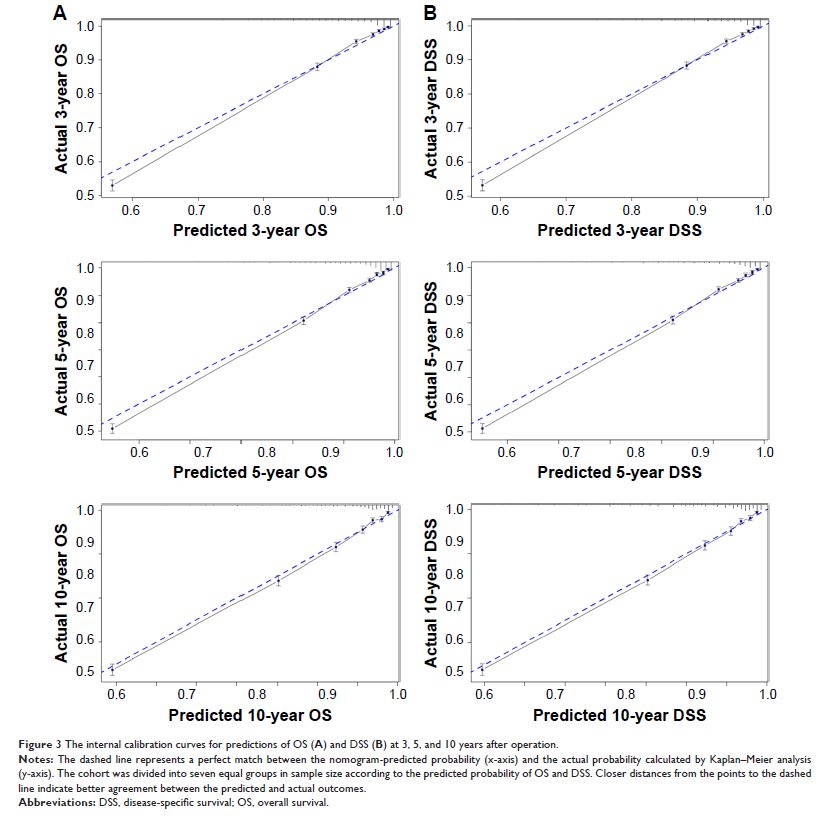9 0 5 7 8
论文已发表
注册即可获取德孚的最新动态
IF 收录期刊
- 2.6 Breast Cancer (Dove Med Press)
- 3.9 Clin Epidemiol
- 3.3 Cancer Manag Res
- 3.9 Infect Drug Resist
- 3.6 Clin Interv Aging
- 4.8 Drug Des Dev Ther
- 2.8 Int J Chronic Obstr
- 8.0 Int J Nanomed
- 2.3 Int J Women's Health
- 3.2 Neuropsych Dis Treat
- 4.0 OncoTargets Ther
- 2.2 Patient Prefer Adher
- 2.8 Ther Clin Risk Manag
- 2.7 J Pain Res
- 3.3 Diabet Metab Synd Ob
- 4.3 Psychol Res Behav Ma
- 3.4 Nat Sci Sleep
- 1.9 Pharmgenomics Pers Med
- 3.5 Risk Manag Healthc Policy
- 4.5 J Inflamm Res
- 2.3 Int J Gen Med
- 4.1 J Hepatocell Carcinoma
- 3.2 J Asthma Allergy
- 2.3 Clin Cosmet Investig Dermatol
- 3.3 J Multidiscip Healthc

诺谟图可用于预测透明细胞肾细胞癌患者的长期总体存活率和疾病特异性存活率
Authors Zhang GH, Wu Y, Zhang JS, Fang ZQ, Liu ZX, Xu ZH, Fan YD
Received 21 April 2018
Accepted for publication 9 August 2018
Published 6 September 2018 Volume 2018:11 Pages 5535—5544
DOI https://doi.org/10.2147/OTT.S171881
Checked for plagiarism Yes
Review by Single-blind
Peer reviewers approved by Dr Colin Mak
Peer reviewer comments 3
Editor who approved publication: Dr Jianmin Xu
Objectives: The aim of this study was to establish comprehensive and practical nomograms, based on significant clinicopathological parameters, for predicting the overall survival (OS) and the disease-specific survival (DSS) of patients with clear cell renal cell carcinoma (ccRCC).
Patients and methods: The data of 35,151 ccRCC patients, diagnosed between 2004 and 2014, were obtained from the database of the Surveillance, Epidemiology, and End Results (SEER) program. The Kaplan–Meier method and Cox proportional hazards regression model were used to evaluate the prognostic effects of multiple clinicopathological variables on survival. Based on Cox models, a nomogram was constructed to predict the probabilities of OS and DSS for an individual patient. The predictive performance of nomograms was evaluated using the concordance index (C -index) and calibration curves.
Results: According to univariate and multivariate analyses, age at diagnosis, sex, race, marital status, surgical approach, tumor node metastasis (TNM) stage, and Fuhrman grade significantly correlated with the survival outcomes. These characteristics were used to establish nomograms. The nomograms showed good accuracy in predicting 3-, 5-, and 10-year OS and DSS, with a C -index of 0.79 (95% CI, 0.79–0.80) for OS and 0.87 (95% CI, 0.86–0.88) for DSS. All calibration curves revealed excellent consistency between predicted and actual survival.
Conclusion: Nomograms were developed to predict death from ccRCC treated with nephrectomy. These new prognostic tools could aid in improving the predictive accuracy of survival outcomes, thus leading to reasonable individualized treatment.
Keywords: clear cell renal cell carcinoma, prognosis, nomogram, survival analysis
